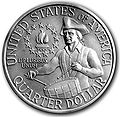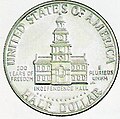United States Bicentennial: Difference between revisions
m →Gallery of images: restore image |
m →Gallery of images: momentary addition in gallery |
||
| Line 62: | Line 62: | ||
Image:Santa Fe SD-45-2 5704.jpg|A [[Atchison, Topeka and Santa Fe Railway|Santa Fe Railroad]] locomotive painted in Bicentennial colors in 1976. |
Image:Santa Fe SD-45-2 5704.jpg|A [[Atchison, Topeka and Santa Fe Railway|Santa Fe Railroad]] locomotive painted in Bicentennial colors in 1976. |
||
Image:VAB aerial 1977.jpg|NASA's Vehicle Assembly Building in 1977. |
Image:VAB aerial 1977.jpg|NASA's Vehicle Assembly Building in 1977. |
||
Image:GenThaddeusKosciuszko Detroit.jpg|Kosciuszko statue, erected 1978, in [[Detroit, Michigan|Detroit]], a gift from the people of [[Krakow, Poland]] in celebration of the United States Bicentennial.<ref>[http://apps.detnews.com/apps/history/index.php?id=165&CFID=9996651&CFTOKEN=10972844 Zacharias, Pat, ''The Monuments of Detroit'', September 5, 1999.] ''[[Detroit News]]''</ref> |
|||
</gallery> |
</gallery> |
||
<gallery> |
<gallery> |
||
Revision as of 23:15, 11 January 2009

The United States Bicentennial was celebrated on Sunday, July 4, 1976, the 200th anniversary of the adoption of the Declaration of Independence.
The War of 1812 Bicentennial is observed between June 18, 2012 through February 17, 2015, dates that correspond with the 200-year anniversary of the war fought and won by the United States against the United Kingdom of Great Britain and Ireland.
Events and observances

The commemoration of the Bicentennial of the United States of America went on for months and is remembered by people of the time as a major cultural event. The United States Mint began issuing special Bicentennial coinage in 1975 (quarters, half dollars and Eisenhower dollars ) dated "1776-1976." As a result, there are no coins of those denominations dated 1975. These coins were also minted throughout 1976. Likewise, the United States Department of the Treasury also released a new version of the $2 bill, featuring a new design on the back: Trumbull's Declaration of Independence.
In October 1973, the Treasury announced an open contest to select suitable designs for the quarter, half dollar, and silver dollar. Over 1,000 designs were submitted. The quarter dollar featured a colonial drummer and a torch encircled by thirteen stars, designed by Jack L. Ahr. The half dollar has Independence Hall on it, designed by Seth G. Huntington. On the silver dollar, designed by Dennis R. Williams, was the Liberty Bell superimposed over the Moon. These coins bore the date "1776-1976". The U.S. Postal Service issued several postage stamps to commemorate the 200th anniversary of various national events connected to the U.S. Bicentennial. It was also the first time in the history of the United States Postal Service that they provided service at select post offices throughout the country on a Sunday.
Official Bicentennial events actually began more than one year earlier, on April 18, 1975. President Gerald Ford came to Boston that day to light a third lantern at the historic Old North Church, symbolizing America's third century. The next day he delivered a major speech commemorating the 200th anniversary of the Battles of Lexington and Concord in Massachusetts, which began the American Revolution against British colonial rule. A "US Bicentennial" postage stamp featuring a painting of the battles by Henry Sandham (1842-1912) was issued that same day to commemorate the milestone.
A special Bicentennial Flag, with a white background and the official Bicentennial Star Emblem, was also displayed or flown as part of honor guards and flag poles throughout the United States during the Bicentennial era, usually to the left or below the American Flag.
Festivities included elaborate fireworks displays in the skies above major American cities. Those in Washington, D.C. were presided over by President Ford and televised nationally. A large international fleet of tall-masted sailing ships gathered first in New York City on the Fourth of July and then in Boston about one week later. These nautical parades, witnessed by several million observers, were named Operation Sail (Op Sail) and this was the second of five such Op Sail events to date (1964, 1976, 1986, 1992 and 2000). The vessels docked and allowed the general public to board the ships in both cities, while their sailors were entertained on shore at various ethnic celebrations and parties.
As the celebration of the Boston Tea Party happened in Boston, a large crowd gathered for the "People's Bi-Centennial". Several people threw packages labelled "Gulf Oil" and "Exxon" into Boston Harbor in symbolic opposition to corporate power.[2]
Queen Elizabeth II of United Kingdom and her husband, Prince Philip, made a special state visit to the USA to tour the country and attend Bicentennial festivities with President and Mrs. Ford. Their visit aboard the Royal Yacht Britannia included stops in Philadelphia, Washington, D.C., Virginia, New York, Connecticut, and Massachusetts.
Local observances included painting mailboxes and fire hydrants red, white, and blue. A wave of patriotism and nostalgia swept the nation and there was a general feeling that the tense era of the Vietnam War and the Watergate constitutional crisis of 1974 had finally come to an end.
In Washington, D.C., the Smithsonian Institution opened a long-term exhibition in its Arts and Industries Building that replicated the look and feel of the 1876 Centennial Exposition of the United States. Many of its museum belongings actually dated from the 1876 World's Fair exposition in Philadelphia that commemorated the 100th anniversary of the independence of the USA. The Smithsonian also opened the permanent exhibition hall for the National Air and Space Museum on 1976-07-01.
NASA commemorated the Bicentennial by painting an American flag and the bicentennial emblem on the side of the Vehicle Assembly Building. The emblem remained until 1998, when it was painted over with the NASA emblem. NASA originally planned for Viking 1 to land on Mars on July 4, but the landing was delayed to a later date.

Many commercial products were marketed in packages tying them to the Bicentennial, usually distinguished by red, white, and blue coloring. The official Bicentennial star emblem was trademarked and only allowed to be used on products by paid license.
Disneyland temporarily changed its "Main Street Electrical Parade" to "America on Parade" and featured the Sherman Brothers' song "The Glorious Fourth". The revamped parade featured nightly fireworks and ran twice a day from 1975-1977.
John Warner, later elected to the United States Senate from Virginia, was director of the Federal office coordinating observances of the Bicentennial.
The State of New Jersey ran a special "Bicentennial Lottery". The winner was awarded $1,776 a week (before taxes) for 20 years (A total of $1,847,040).
The USOC initiated two American bids to host both the 1976 Summer and Winter Olympic Games to celebrate Bicentennial. Los Angeles bid for the 1976 Olympics but lost to Montreal, Canada. Denver was awarded the 1976 Olympic Winter Games in 1970, but due to risings costs, the state of Colorado voted to back out of its organizational committments and the IOC reawarded the 1976 Winter Olympics to Innsbruck, Austria, host of 1964. As a result, there was no American Olympics in 1976 (however Lake Placid would go on to host the 1980 Winter Olympics, and Los Angeles would eventually be awarded the 1984 Olympics.
In his 1976 New Year's Eve Show, Dutch comedian Wim Kan commented: "The United States celebrating they exist two hundred years? Even our State Lottery is older!"
The Bicentennial on television
Related Network Television Programs aired July 3-4, 1976
- Great American History Test (CBS)
- Inventing of America (NBC)
- In Celebration of US (CBS), 14 hour coverage hosted by Walter Cronkite
- Glorious Fourth (NBC), 10 hour coverage
- Great American Birthday Party (ABC), hosted by Harry Reasoner
- Happy Birthday, America (NBC), hosted by Paul Anka
- Bob Hope's Bicentennial Star-Spangled Spectacular (NBC)
- Best of the Fourth (NBC), recap with David Brinkley and John Chancellor
Saturday morning Bicentennial programs
In the months approaching the Bicentennial, Schoolhouse Rock, a series of educational cartoon shorts running on ABC between programs on Saturday mornings, created a sub-series called "History Rock," although the official name was "America Rock." The ten segments covered various aspects of American history and government. Several of the segments, most notably one dealing with the preamble of the Constitution put to music, have become some of Schoolhouse Rock's most popular segments.
And in 1975, CBS did its bit on Saturday morning with a new animated Archie series, The U.S. of Archie; unfortunately, that version was unsuccessful, and was off the air by September 1976.
Gallery of images
-
Italian tall ship Amerigo Vespucci in New York Harbor during the celebration.
-
A Santa Fe Railroad locomotive painted in Bicentennial colors in 1976.
-
NASA's Vehicle Assembly Building in 1977.
-
Kosciuszko statue, erected 1978, in Detroit, a gift from the people of Krakow, Poland in celebration of the United States Bicentennial.[3]
-
Reverse of the Bicentennial quarter, minted 1975-1976.
-
Reverse of the Bicentennial half dollar, minted 1975-1976.
-
Reverse of the Bicentennial dollar, minted 1975-1976.
See also
References
- ^ Zacharias, Pat, The Monuments of Detroit, September 5, 1999. Detroit News
- ^ Zinn, Howard. A People's History of the United States. New York: Perennial, 2003. p.562 ISBN 0060528370
- ^ Zacharias, Pat, The Monuments of Detroit, September 5, 1999. Detroit News



![Kosciuszko statue, erected 1978, in Detroit, a gift from the people of Krakow, Poland in celebration of the United States Bicentennial.[3]](http://upload.wikimedia.org/wikipedia/commons/thumb/0/0a/GenThaddeusKosciuszko_Detroit.jpg/89px-GenThaddeusKosciuszko_Detroit.jpg)


